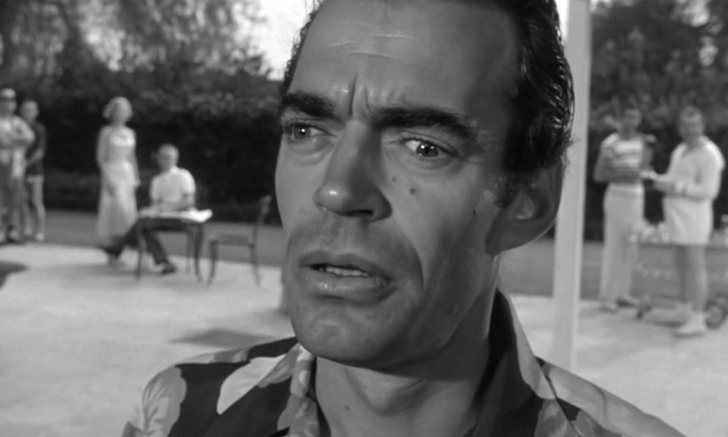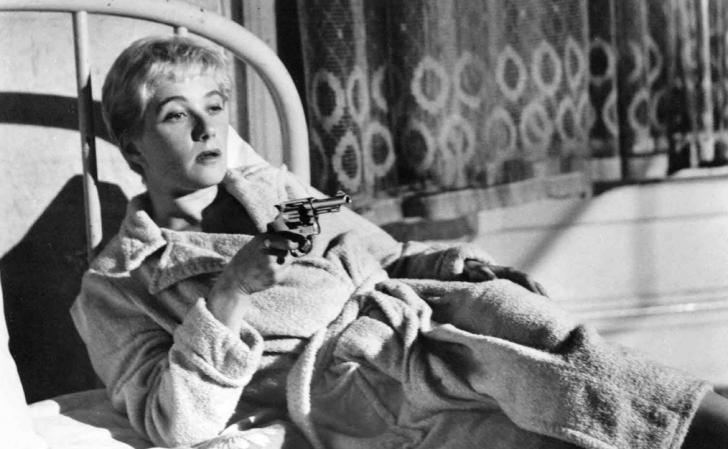Film noir’s opaque shadows will fall on Boston this June when the traveling film festival Noir City slinks onto the screen of Harvard Square’s Brattle Theatre. For those who believe Billy Wilder’s nasty, lusty Double Indemnity was, in 1944, the jolt that brought noir’s patchwork monster to life (a debatable take, to be sure, especially when you trace noir’s roots back to German Expressionism), then 2019 is the 75th anniversary of the genre’s dark inception. Thousands of cycles of hybridization later, the origin points of film noir continue to feel fresh…and freshly ominous.

Indemnity may have marked the beginning, but another staple showing on Noir City’s program, Robert Aldrich’s Kiss Me Deadly from 1955, self-consciously signaled the end of film noir’s brazen first act, before the genre’s conventions were mitigated and absorbed into just about every other genre of film. It does so by both subverting and ratcheting up what noir had been for over a decade; the lurchy, low-budget menace, the dog-eared charm and broken soulfulness, the abrupt ferocity wired into the genre are all mutated in one way or the other in Kiss Me Deadly. Its stark black-and-white imagery is rendered dark and dangerous all over again, looking ahead to category-busting films like Charles Laughton’s Night of the Hunter (six months after Kiss’ release), Alfred Hitchcock’s Psycho (1960), and George Romero’s Night of the Living Dead (1968). While sex and violence had always been an inherent, yet mostly implied, component of the genre (collateral from the curdling conservatism of the post-War period), Kiss Me Deadly moves it front and center, out of the shadows and under a white-hot light for all to see.
And, boy, do you see it in Kiss. The film takes noir’s tropes to the breaking point: consider the opening focus on the fleeing gams of a woman (they belong to Cloris Leachman, in her film debut). And much like it was in the crime noir landmarks Detour (Edgar G. Ulmer, 1945), D.O.A. (Rudolph Maté, 1950), and Cornell Woolrich’s novel I Married a Dead Man, this establishes panic as the defining atmosphere. But whereas those stories were infused with slivers of empathetic melancholy and followed their openings with a flashback to a more innocent moment along the characters’ paths, Kiss has Leachman’s Christina Bailey, clothed only in a trench coat, explode onto the screen never to look—or flash—back. It’s a propulsive ride forward from there, becoming bleaker and more bewildering as it careens toward its finale. Of course, to underscore the often absurd, nihilistic coincidences that are flecked throughout noir, it is fait accompli that Christina will end up staring down the grill of private detective Mike Hammer’s (Ralph Meeker) car.

And what about Hammer’s place in the pantheon of anti-heroic, semi-crusading sleuths? If you crossed Bogart’s myriad of cinematic dicks with Harrison Ford’s Rick Deckard of Blade Runner (1982), minus the kid gloves with women and…well, charm and intelligence, mostly, then you’d have Meeker’s Hammer. Bogart’s Sam Spade and the countless screen portrayals of Philip Marlowe belie a damaged soul underneath the hard-boiled shell, yet many of them are apt to go gunless, or at least to not consciously or overtly seek out violence unless it’s in defense of self. Here, Hammer knows how to hurt and does so without ever having to assign it as a last resort; he breaks fingers, slaps men young and old, beats heads against cement walls, and occasionally delivers a mystical judo chop that completely incapacitates his opponent (the blows, doled out twice, are never shown on screen). He revels in violence rather than utilize it strategically. There are allusions to just how brutally egocentric Hammer is, too: Christina has him pegged immediately when she describes him as a guy that takes care of one thing…himself. Hammer’s mechanic pal, Nick Va Va Voom (Nick Dennis), is asked by his garage assistant what Hammer gets out of giving up his new car to Nick, hinting at how dangerously self-centered he knows him to be, too much to be simply doing something out of generosity of spirit. “Trouble.” the assistant mutters, answering himself. Hammer’s narcissism blinds him, too; indeed, Slant Magazine film writer Glenn Heath, Jr. notes, “Mike’s inability to grasp the truth reveals a crippling limited perspective, personifying an extreme form of vicious masculinity that seems destined for a grave.”
No matter how you interpret the ending—eradication by a near–sentient nuclear source, a supernatural or alien presence (the opening of the iconic briefcase, with its accompanying eerie chanting and blinding-light destruction, hints at the decade’s fertile cinematic science fiction)—it’s pretty clear there’s no way out for the characters, nor for, perhaps, humanity. When Sam Spade acknowledges the inconsequentiality and infuriating existentialism of the bird statue at the close of 1941’s The Maltese Falcon (the true start of film noir?), the audience can take solace in that his adventures will continue, that peace evades him for now, not permanently. In Kiss Me Deadly’s finale, a gut-shot Hammer wades into the inky darkness of the crashing shoreline waves, a bleak reminder that we’ll all eventually be consumed and washed away. What a grand kiss-off.
